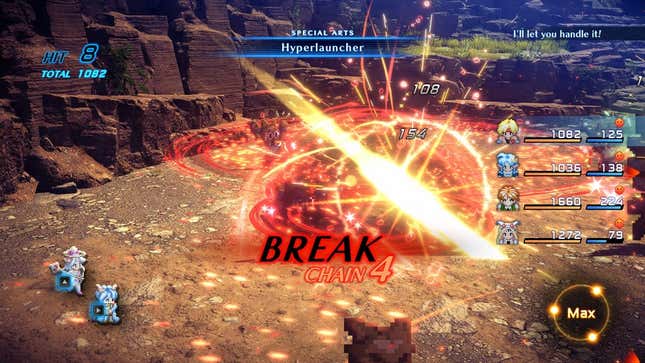
Every Friday, A.V. Club staffers kick off the weekend by taking a look at the world of gaming, diving in to the ideas that underpin the hobby we love with a bit of Game Theory. We’ll sound off in the space above, and invite you to respond down in the comments, telling us what you’re playing this weekend, and what theories it’s got you kicking around.
There’s a particular kind of artistic confidence—most especially visible in gaming, the medium that lets this sort of thing happen most readily—that can only really be exhibited by letting people trash your shit. It’s a bit like a clockmaker building a beautiful apparatus, and then hiding within it a whole bunch of tools that will let the public clog the gears, break the pendulum, and smash that damn cuckoo to pieces: If your thing (or game) is good enough, it’ll survive this process of being pushed to its limits, intact. If not, well... That’s confidence for ya.
Star Ocean: The Second Story R (see on Amazon), released last week by Square-Enix, isn’t just a throwback because it is, quite literally, a very faithful remake of a 25-year-old video game. It’s also a throwback because that specific game—released by the gorgeous weirdos at Japanese studio Tri-Ace, their first title to ever get a U.S. release—was and is one of the most beautifully breakable role-playing games ever made. Massively ahead of its time back in 1998 (and still kind of revolutionary now, honestly), The Second Story doesn’t just invite players to engage with its various systems—it encourages them to exploit them, rewarding experimentation with huge boosts in power that sometimes threaten to blow the game’s whole difficulty curve to shreds, because, well, why the hell not?
Even back in ’98, the plot of Star Ocean 2 was fairly minimal—basically, “What if a world-ending fantasy adventure and an episode of Star Trek were happening at the same time, in the same place?” Its combat was a revelation, though, one of the first Japanese role-playing games to incorporate serious action elements into the standard “tap the menu” fighting of their predecessors. (The other notable one of the era being Namco’s Tales Of Destiny; both games were follow-ups to Super Famicom titles that wouldn’t get a U.S. release for years to come, after these games paved the way.)
Where The Second Story got really dumb, though—“dumb” in the way a roller coaster that flips you a dozen times in quick succession is dumb, which is to say “awesome”—was with its Skill system. Separate from the usual business of leveling up with experience, this was a highly varied character customization system that also served as the game’s crafting mechanic. And its fast-travel system. And a way to screw with the rate it throws random battles at you. And a cooking minigame. And a developer hint system. And…

Look, the point is that Tri-Ace (and developer Gemdrops, which created the later versions of the game, adding a few new tweaks to the system in the process) got really, aggressively silly with the Skills, letting players get their hands on a bunch of things that JRPGS—especially JRPGs of that era—never really let people get at without forking out cash for a Gameshark. It takes a bit of initial investment on the player’s part, but once these systems get rolling, they all build on each other—almost literally, in the form of the whole skill branch that lets you write books that improve the levels of other skills—in ways that no sensible designer, trying to make a balanced system, would allow.
And that is because, pretty clearly, everyone involved in making, and then re-making, Star Ocean 2 realized that “balance” is not, in and of itself, automatically a good thing. Much lip service is paid to the idea of balance these days, especially in any game—i.e., most games—that have any kind of multiplayer options. Players “should,” the argument goes, all operate on roughly the same power curve, getting stronger at about the same rates. Which totally ignores the fact that unbalancing systems is fun, if it’s happening in your favor; seeking out these kinds of synergies and exploiting them to the hilt is a big reason that people play games in the first place. The first time you crack into The Second Story’s Skills and realize you can write books that boost your alchemy so you can make late-game materials for the blacksmithing system, etc., etc., and realize you can make some really busted-good armor and weapons that can carry you through the next 10 hours of fights, is the moment the game goes from “pleasant nostalgia trip” to “beautifully illustrated power fantasy.” We picked up The Second Story R to honor old memories; we’re playing the whole damn thing because it makes breaking its systems in half such compulsive, wonderful fun.
Buy Star Ocean: The Second Story R: Amazon | Best Buy | GameStop
.